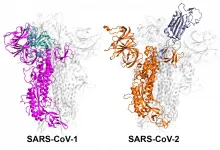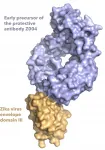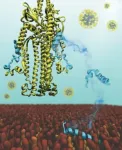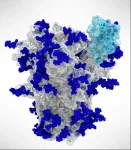One California community shows how to take the waste out of water
Urban Monterey and agricultural Salinas have developed a first-of-its-kind water recycling program that takes a sustainable approach to overcoming the challenge of water scarcity.
2021-02-25
(Press-News.org) Caught between climate change and multi-year droughts, California communities are tapping groundwater and siphoning surface water at unsustainable rates.
As this year's below-average rainfall accentuates the problem, a public-private partnership in the Monterey/Salinas region has created a novel water recycling program that could serve as a model for parched communities everywhere.
As Stanford civil engineers report in the journal Water, this now urbanized region, still known for farming and fishing, has used water from four sources -- urban stormwater runoff, irrigation drainage, food processing water and traditional municipal wastewater -- and treated it so that this recycled water now supplies one-third of all drinking water on the Monterey Peninsula while providing irrigation water for 12,000 acres of high-value crops in the northern Salinas Valley.
This first-of-its-kind program creates a sustainable management plan by taking a "one water" approach that considers all of the region's water, new and used, as part of one network. The effort began in 1972 when agricultural, residential and industrial users started the process of consolidating their individual wastewater treatment plants into one regional center to meet the stricter environmental standards of the federal Clean Water Act. The idea was to reuse wastewater to irrigate fruit and vegetable crops. But first they had to determine whether it was safe. Their landmark study affirming the safety of this plan led to a $75 million water treatment and distribution system that opened in 1998 and pioneered the practice of using recycled water to irrigate freshly edible fruit and vegetable crops.
But while the irrigation water system was under development, seawater intrusion continued to threaten the region's groundwater supplies. State authorities declared a key aquifer critically overdrafted. And the State Water Board ordered the Peninsula's private water supplier, California American Water, to stop excessive pumping from the Carmel River. The region, which had already formed the Monterey One Water utility to implement the crop irrigation project, responded with another water recycling innovation. In collaboration with other groups, Monterey One Water collected wastewater from urban runoff, irrigation drainage and food processing plants to create a $124 million treatment plant that opened in 2020. Its goal is to bring this former wastewater up to potable standards and then store it in the groundwater basin where it is later pumped for drinking water supply.
The research team studied the history, agreements, design and performance of Monterey's one water program to help other communities considering similar approaches. But the region can't rest on its laurels. Peninsula communities are currently considering whether to invest in a $60 million expansion to its recycled water system, or spend $400 million to build a seawater desalination project. This high-stakes decision depends on how soon water demand will outpace recycled water supply, which has been variously estimated at 10, 20 or 30 years. The wrong decision would be costly to local ecosystems and residents, who already pay among the highest water rates in the nation.
Dick Luthy, the Silas H. Palmer Professor of Civil and Environmental Engineering at Stanford and a co-author of the article in Water, said the region has the proper mindset to make the right call because its agricultural, residential and industrial users have a history of cooperating instead of bickering.
"The moral of the Monterey/Salinas story is that working collaboratively and imaginatively, different users in water-scarce regions can address their challenges in ways that are equitable, protective of the environment and supportive of local economies."
INFORMATION:
Bridget Gile is first author of the paper in Water. Postdoctoral scholar Negin Ashoori and Paul Sciuto with Monterey One Water are also co-authors.
ELSE PRESS RELEASES FROM THIS DATE:
2021-02-25
UNIVERSITY PARK, Pa. -- When healthcare workers become ill during a disease outbreak, overall case counts and mortality rates may significantly increase, according to a new model created by researchers at Penn State. The findings may help to improve interventions that aim to mitigate the effects of outbreaks such as COVID-19.
"Each year dozens of potentially lethal outbreaks affect populations around the world. For example, Ebola ravaged western Africa in 2014; Zika damaged lives in the Americas in 2015; and now we are in the midst of a worldwide pandemic -- COVID-19," said Katriona Shea, professor of biology and Alumni Professor in the Biological Sciences, Penn State. "Healthcare ...
2021-02-25
New York, NY (February 25, 2021) -- Early detection could reduce the number of African Americans dying from liver cancer, but current screening guidelines may not find cancer soon enough in this community, according to a study published in Cancer in February.
Black patients with liver cancer often have a worse prognosis than those of other racial and ethnic groups. Mount Sinai researchers sought to understand the reasons for this disparity by studying patients with hepatitis C, the leading driver of liver cancer in the United States.
Hepatitis C virus infection can result in cirrhosis, ...
2021-02-25
Feb. 25, 2021 - A new paper published online in the Annals of the American Thoracic Society provides a roadmap that critical care clinicians' professional societies can use to address burnout. While strongly needed prior to the COVID-19 pandemic, the roadmap has taken on even greater urgency due to reports of increasing pandemic-related burnout.
In "Professional Societies' Role in Addressing Member Burnout and Promoting Well-Being," Seppo T. Rinne, MD, PhD, of The Pulmonary Center, Boston University School of Medicine, and co-authors from a task force created by the Critical Care Societies Collaborative (CCSC) describe a rigorous process they used to document 17 major professional ...
2021-02-25
The Clalit Research Institute, in collaboration with researchers from Harvard University, analyzed one of the world's largest integrated health record databases to examine the effectiveness of the Pfizer vaccine against COVID-19. The study provides the first large-scale peer-reviewed evaluation of the effectiveness of a COVID-19 vaccine in a nationwide mass-vaccination setting. The study was conducted in Israel, which currently leads the world in COVID-19 vaccination rates.
The results of this study validate and complement the previously reported findings of the Pfizer/BioNTech ...
2021-02-25
Boston, MA - A new approach to pooled COVID-19 testing can be a highly effective tool for curbing the SARS-CoV-2 pandemic, even if infections are widespread in a community, according to researchers at Harvard T.H. Chan School of Public Health and the Broad Institute of MIT and Harvard. Simple pooled testing schemes could be implemented with minimal changes to current testing infrastructures in clinical and public health laboratories.
"Our research adds another tool to the testing and public health toolbox," said Michael Mina, assistant professor of epidemiology at Harvard Chan School and associate member of the Broad. "For public health agencies and clinical laboratories ...
2021-02-25
ROCKVILLE, MD - Coronavirus outbreaks have occurred periodically, but none have been as devastating as the COVID-19 pandemic. Vivek Govind Kumar, a graduate student, and colleagues in the lab of Mahmoud Moradi at the University of Arkansas, have discovered one reason that likely makes SARS-CoV-2, the virus that causes COVID-19, so much more infectious than SARS-CoV-1, which caused the 2003 SARS outbreak. Moradi will present the research on Thursday, February 25 at the 65th Annual Meeting of the Biophysical Society
The first step in coronavirus infection is for the virus to enter cells. For this entry, the spike proteins on the outside of ...
2021-02-25
ROCKVILLE, MD - The Zika outbreak of 2015 and 2016 is having lasting impacts on children whose mothers became infected with the virus while they were pregnant. Though the numbers of Zika virus infections have dropped, which scientists speculate may be due to herd immunity in some areas, there is still potential for future outbreaks. To prevent such outbreaks, scientists want to understand how the immune system recognizes Zika virus, in hopes of developing vaccines against it. Shannon Esswein, a graduate student, and Pamela Bjorkman, a professor, at the California Institute of Technology, have new insights on how the body's antibodies attach to Zika virus. Esswein will present the work, which was published in PNAS, on Thursday, February ...
2021-02-25
ROCKVILLE, MD - If the coronavirus were a cargo ship, it would need to deliver its contents to a dock in order to infect the host island. The first step of infection would be anchoring by the dock, and step two would be tethering to the dock to bring the ship close enough that it could set up a gangplank and unload. Most treatments and vaccines have focused on blocking the ability of the ship to anchor, but the next step is another potential target. New research by Defne Gorgun, a graduate student, and colleagues in the lab of Emad Tajkhorshid at the University of Illinois addresses the molecular details of this second step, which could inform the design of drugs that block it. Gorgun will present her research on Thursday, February 25 at the ...
2021-02-25
ROCKVILLE, MD - The virus that causes COVID-19 belongs to the family of coronaviruses, "corona" referring to the spikes on the viral surface. These spikes are not static--to infect cells, they change shapes. Maolin Lu, an associate research scientist at Yale University, directly visualized the changing shapes of those spike proteins and monitored how the shapes change when COVID-19 patient antibodies attach. Her work, which was published in Cell Host & Microbe in December 2020 and will be presented on Thursday, February 25 at the 65th Annual Meeting of the Biophysical Society informs the development of ...
2021-02-25
ROCKVILLE, MD - One thing that makes SARS-CoV-2, the virus that causes COVID-19, elusive to the immune system is that it is covered in sugars called glycans. Once SARS-CoV-2 infects someone's body, it becomes covered in that person's unique glycans, making it difficult for the immune system to recognize the virus as something it needs to fight. Those glycans also play an important role in activating the virus. Terra Sztain-Pedone, a graduate student, and colleagues in the labs of Rommie Amaro at the University of California, San Diego and Lillian Chong at the University of Pittsburgh, studied exactly how the glycans activate SARS-CoV-2. Sztain-Pedone will present the research on Thursday, February 25 at the 65th Annual Meeting ...
LAST 30 PRESS RELEASES:
[Press-News.org] One California community shows how to take the waste out of water
Urban Monterey and agricultural Salinas have developed a first-of-its-kind water recycling program that takes a sustainable approach to overcoming the challenge of water scarcity.





